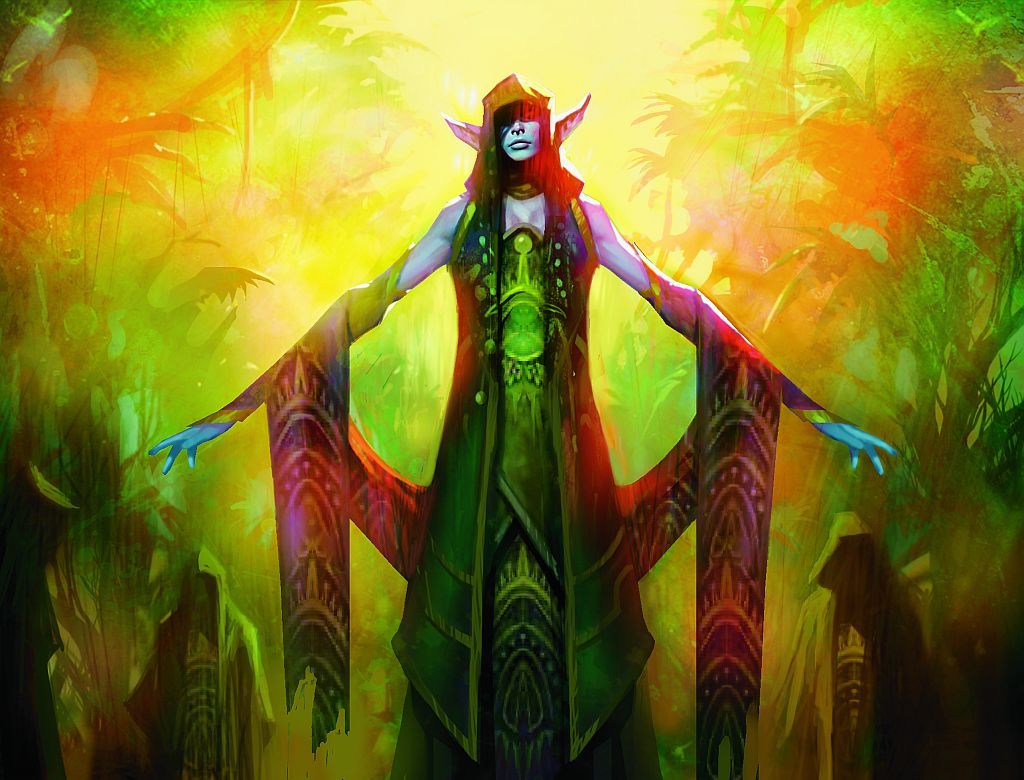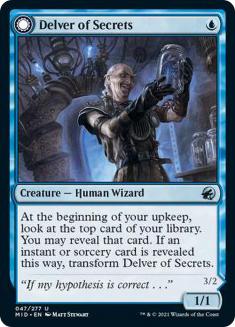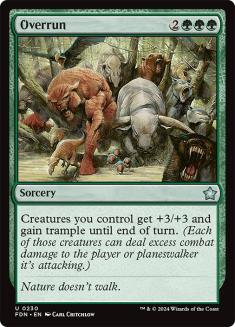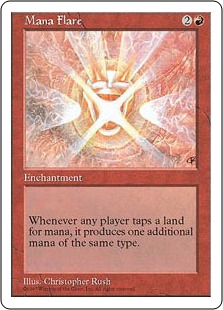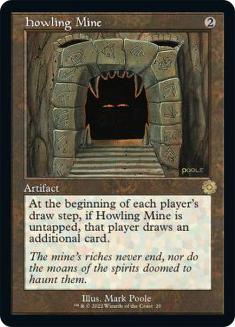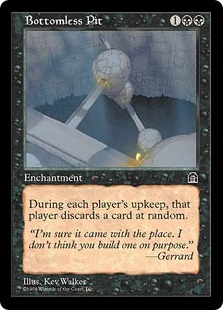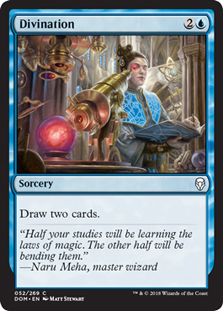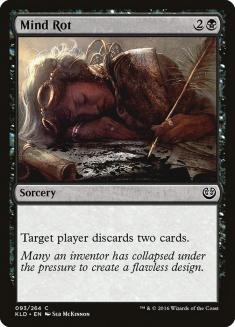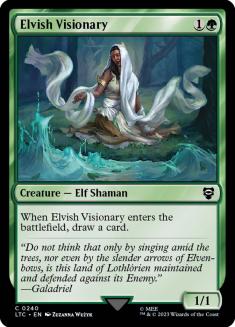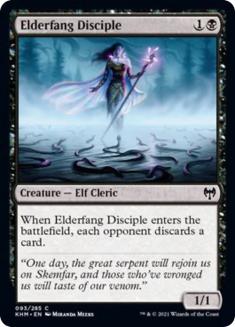We often talk about card advantage as the absolute value of a number — if you destroy a creature with a cantrip, that’s a two-for-one, and if you destroy two creatures with one card, that’s also a two-for-one. Assuming your opponent has a card in hand, Elvish Visionary and Elderfang Disciple both “leave you up a 1/1,” but these are far from the same effect and I believe there’s a lot to unpack in the difference.
Big Games VS Small Games
All of these exchanges, and in a way, most cards cast and most plays made in a game of Magic can be thought of as “voting” for either a big game or a small game. In big games, players have more cards/resources at their disposal; in small games, players have fewer.
A card that creates resources or draws cards votes for a big game, and a card that denies access to cards, generally putting them in the graveyard, exile, or library, votes for a small game. Choosing to trade creatures by attacking into a blocker or blocking an attacker votes for a small game, and choosing not to trade by declining to attack or block votes for a big game.
Big games and small games play out differently in fairly consistent and often obvious ways. Cards affecting multiple creatures, Magic’s version of “area of effect” spells – anything from Glorious Anthem to Wrath of God – are better in big games, while cards with single targets are relatively better in small games.
The Count
We can think about the size of a game with a literal card count. Each game in which players don’t mulligan starts with a size of fourteen, the total number of cards players have access to. Each turn the count increases by one, but when two cards trade, the count decreases by two.
Things get messy quickly in terms of whether you want to count lands separately from creatures or other things, whether you want to count cards in hand differently from cards on the battlefield, and how you count creatures differently based on size and handling tokens, but on some level, there’s a fundamental difference between how games play/feel when they have a total count of ten cards between both players’ hands and cards on the battlefield and a count of 30.
Because some cards are predictably better with high counts and others are predictably better with low counts, certain decks want to focus deeply on prioritizing cards that vote for small games over cards that vote for big games or the other way around. Temur Delver in Legacy is a great example of a deck that’s hyper-focused on voting for small games. It plays cards like Daze that are much weaker in large games, so it wants to trade down resources at every opportunity, especially the versions with Stifle. By contrast, ramp decks generally want big games because they need a large number of total resources to cast their expensive spells, and they vote for large games by minimizing the number of removal/interactive spells in their decks.
We can generalize truths about games based on their total card count and the size of the game, but there are meaningful distinctions between different kinds of cards, so big games in particular should be divided into games with large battlefields (high creature count); high-resource games (lots of mana, generally because large numbers of lands are on the battlefield); and games where players have a lot of cards hand.
Large Battlefields
When a game has a large battlefield with lots of creatures on both sides of the table, the fact that the combat rules in Magic favor the defender, allowing them to choose which creatures block (including double blocking) means that attacking will become harder. Large battlefields tend towards standoffs.
A standoff naturally decreases the extent to which a game is about tempo, meaning that it is less likely that the bottleneck in a game will be a player’s ability to spend mana. It’s more likely that, during a battlefield stall, both players will be able to play all of their cards, and ultimately, the player who can do the most powerful thing, which is generally the player with more expensive cards, but sometimes the player with better synergy or a plan better-suited to a big game, will win.
Because large battlefields tend to result in standoffs, evasion is a priority in these kinds of games. Further, any kind of Glorious Anthem, Overrun, or even Safe Passage effect will play best in games like this, and decks that play those cards should try to engineer large battlefields.
Tempo VS Attrition
Before I get too far into the weeds on tempo VS attrition, let me start by addressing my framework for those terms. To my mind, tempo and attrition are opposite ends of a spectrum. Tempo games revolve around a mana bottleneck and attrition games revolve around a card count bottleneck. Tempo games are won by the player who doesn’t give their opponent time to use all of their resources, and attrition games are won by the player who depletes all of their opponent’s resources.
Not all games can be perfectly described as either — sometimes a game is won by an unanswered trump, like a large flying creature that the opponent can’t answer even if they can cast all of their spells. They have plenty of cards but those cards just don’t line up right.
Not all games care about the tempo VS attrition axis or spectrum, but we can expect that a game will revolve around either tempo or attrition, not both. This distinction is useful for making decisions like play VS draw, where being on the play is better in tempo games and being on the draw is better in attrition games (and yes, almost all games of Constructed tend toward valuing tempo over attrition).
High-Resource Games
In high-resource games, a relatively large portion of the resources available to players generate mana. This could be because we’re late in the game and both players have a lot of lands, or it could be because of an effect like Veteran Explorer or Mana Flare.
In high-resource games, we can expect that the bottleneck isn’t a player’s ability to spend mana but rather the player’s ability to find things to spend their mana on. A high-resource game isn’t a tempo game, because we expect that both players are able to cast all their spells as they choose at this stage. It can be thought of as an attrition game, but true attrition games are generally small games, and high-resource games are big games.
It’s more likely that a high-resource game will be won by a trump than by exhausting the opponent’s resources. High-resource games tend to be won by the player whose cards have the higher total casting cost, though other mana sinks outside of casting costs can very easily swing that.
Big Hands
The last kind of big game is one where both players have a lot of cards, generally more than they can expect to cast. Games with a Howling Mine on Turn 2 have a unique big-hand feel, where we expect both players to play a land and spend all their mana every turn. This kind of big game typically favors the player with cheaper spells and strongly prioritizes tempo over attrition.
Small Games
In small games, typically a lot of cards trade and both players are left with relatively few remaining resources. Because modern design sensibilities discourage land destruction as a form of resource denial, we don’t typically see land destruction as a source of small games outside of Legacy. Since games typically slow down when a lot of mana is invested in exchanging resources, small games are sometimes a precursor to high-resource games, typically when neither player manages to leverage an advantage before reaching that stage.
In small games, anything that sticks matters more than it would in a big game. A small vanilla creature is a clock if it’s the only thing on the battlefield, while it can be merely a chump blocker when there are a lot of big creatures around. Advantages that we think of as “a fraction of a card” like an additional 1/1 token or +1/+1 counter are a lot more likely to matter in small games.
At the same time, each draw step is much swingier and more impactful in a small game because it represents a larger portion of the total power in a game, so a single impactful topdeck can swing the advantage in a small game much more easily than in a big game (unless it’s an effect that’s specifically intended to swing big games, like Upheaval or Overrun).
Elvish Visionary VS Elderfang Disciple
So what does this mean for Elvish Visionary and Elderfang Disciple, and why am I interested in those cards rather than, for example, Divination VS Mind Rot?
I think the difference between Divination and Mind Rot is fairly clear, but I think it’s easy to confuse Elvish Visionary and Elderfang Disciple. Specifically, I think it’s easy to misapply what we know about using Elvish Visionary to Elderfang Disciple.
There are legitimately decks that are just looking for a two-mana value creature and they don’t care very much which one they have. Elvish Visionary and Elderfang Disciple have a lot in common. Both are relatively strong in attrition games and relatively weak in tempo games because they’re a low-impact use of mana, and both are relatively good ways to get a creature when you don’t care what the creature is — maybe you want to sacrifice it, maybe you have to equip a powerful piece of Equipment like Umezawa’s Jitte to it, or maybe you’re looking to blink all your creatures with Yorion, Sky Nomad and you just want to pile up enters-the-battlefield effects.
The difference is that Elvish Visionary votes for large games and Elderfang Disciple votes for small games. If you’re used to using Elvish Visionary in Elf deck that plays a lot of lords and Overruns, you might think, “This value Elf is pretty good because it makes all my mass effects better, and I have so much pump that I don’t care much about the base size of its body,” and you might expect Elderfang Disciple to work similarly well.
But decks with a lot of lords and Overruns want big games, not small games. Elvish Visionary draws you toward more lords and Overruns, whereas Elderfang Disciple is just a low-impact card. Your strategy attacks in a very specific way and ends games fairly quickly, so it’s extremely likely that your opponent has a card that doesn’t line up well or that they wouldn’t cast, so the “value” generated by Elderfang Disciple typically isn’t worth anything to you.
More broadly, pay attention to whether your deck wants big games or small games and don’t play effects or cards that vote for the wrong kind of game.
So when is Elderfang Disciple best? Clearly it’s when you want to vote for a small game, but what are the criteria for that vote? Typically, when your opponent wants to vote for a big game — for someone playing a normal midrange deck, Elderfang Disciple would be a better play than Elvish Visionary against Elves unless that person needs to draw toward a scaling effect such as a mass removal spell — but all you have is one-for-ones, two-for-ones, or cards that don’t scale indefinitely, you want all your cards to vote for a smaller game to stop your opponent from compounding their synergies.
Elderfang Disciple is better to pair with Equipment than Elvish Visionary is. Equipment makes one creature better at a time, so it doesn’t scale well to large battlefields, and it costs mana to use, so it doesn’t play well with drawing additional cards (which also require mana to use). Broadly, cards that vote for smaller games, particularly fewer cards in hand, play better with mana sinks than cards that draw cards.
One last note about the difference between these creatures: casting Elvish Visionary is generally “strictly better” than doing nothing — the card replaced itself and you have a 1/1 on the battlefield. The same is not true of Elderfang Disciple.
If you have a generic Limited deck that doesn’t have enough two-mana plays, Elvish Visionary is a reasonable consideration as a way to moderately productively spend two mana. This doesn’t mean you always want to cast it – there are opportunity costs, and until you do spend that two mana, you could have had another card in your hand that might have given you better options – but it has a higher floor than Elderfang Disciple. If you’re playing an aggressive deck and you don’t expect that your opponent will get to use all of their cards anyway, Elderfang Disciple essentially doesn’t have text, and spending two mana to cast a 1/1 is generally worse than doing nothing, as a 1/1 is generally less valuable than a card in your hand.
Diminishing Marginal Returns
Magic has a lot of pressure to focus your deck on a certain gameplan or a block of synergies. Elvish Archdruid scales pretty well with additional Elvish Archdruids, but at the same time, you get rapidly diminishing returns on additional Elvish Archdruids. You reach a point where you just have enough mana and big enough creatures, and you’ve either already won or you’ve established that the thing Elvish Archdruid does isn’t going to win (maybe your opponent has an Ensnaring Bridge or an infinite life combo).
Decks that are exclusively one-dimensional are rarely successful because there are too many ways to disrupt any particular strategy, so you need to be able to interact in some way, and usually in multiple ways. This leads to interesting questions about what Magic would look like if the “four copies of a card” limit didn’t exist in a world where cards like Black Lotus and Ancestral Recall aren’t legal, in that there would still be a strong pressure for reasonably diverse decklists, though we might see a lot of decks resembling “ten Champion of the Parish, twelve Thalia’s Lieutenant, and some interactive spells.”
What this means is that you shouldn’t obsess too much about making sure that all of your cards vote the same way. Decks that want big games generally still play a few answers even if those shrink the size of a game, and drawing cards is good in small games, which is why control decks play a mix of removal and card draw.
If you have a lot of Elvish Visionaries, you might be better off if one is an Elderfang Disciple, since you might bottleneck on your ability to deploy your resources and Elderfang Disciple pressures your opponent’s resources without demanding additional mana. This is not likely to be a point you’d reach in an Elf deck, but it definitely comes up in Yorion decks, which also want large games — it’s easy for Yorion decks to play large numbers of cards that draw cards when they enter the battlefield and then find that Yorion draws cards that they can’t efficiently deploy, whereas if they can focus on blinking cards that attack the opponent’s resources, it’s easier to grind them down without needing additional time and mana to do that.
The reverse is even more clearly true — multiple Elderfang Disciples play well together because each forces your opponent to discard a better card than the last, as they’ve already discarded their worst card, but eventually you reach the point where your opponent has no hand and additional copies are horrible. Again, the incentives in Magic skew toward some level of moderation.
As always, it all comes down to having a robust gameplan and thinking about exactly how a card will play into that, but if you think about card advantage as adding to (Divination) or subtracting from (Mind Rot) the total game size count, you might find it easier to parse whether cards are contributing to the kind of game you want to be playing than if you just think about the quantifiable advantage they convey in number of cards as an absolute value.

